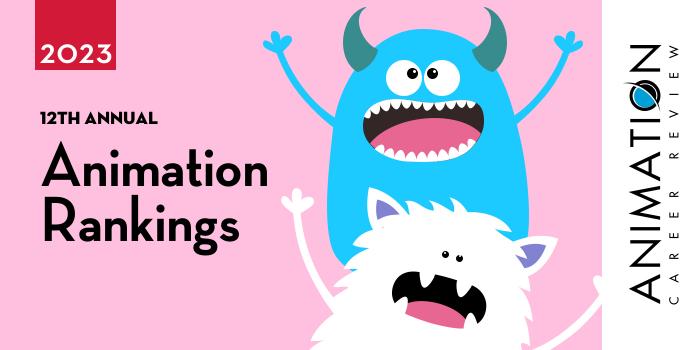
Become a 3D animator for film and games! Get specialized training to fast-track your career with CG Spectrum’s online 3D animation courses. Learn directly from expert animators working on hit films and best-selling games. Find out more.

| Ranking | School | City |
|---|---|---|
| 1 | The Ohio State University | Columbus |
| 2 | Columbus College of Art & Design | Columbus |
| 3 | Cleveland Institute of Art | Cleveland |
| 4 | Bowling Green State University | Bowling Green |
| 5 | Ohio University | Athens |
Our 2023 ranking -our twelfth annual- of the top animation school programs in Ohio. For an explanation of the ranking criteria, click here.

The College of Arts and Sciences at The Ohio State University (OSU) houses 38 departments, more than 20 research centers, and over 2,000 faculty and staff members that provide more than 80 majors, 100+ minors and certificates, and over 50 graduate programs. Among the College’s programs are several pathways to study animation.
Established in 2017, OSU’s interdisciplinary Moving Image Production (MIP) BA Program is a collaboration between The Departments of Theatre, Film, and Media Arts; Art; Design; and the Advanced Computing Center for the Arts and Design (ACCAD).
The program, which combines live-action and animated filmmaking, features studio practice in Animation, Experimental, Narrative, and Documentary. Course examples include Motion Studies Through Hand-Drawn Animation, Computer Animation: Form, Light, Motion I & II Group Studies in Digital Animation and Interactive Media, Concept Development for Time-Based Media, and Film/Video: Topics in Technologies and Strategies.
OSU MIP students will take a 15 credit hour Flim Studies Minor as part of the program, and they will have opportunities to take additional production and screenwriting courses through electives, complete an internship, and participate in the school’s study abroad program.
The Department of Art houses the Art and Technology Area. Undergraduate students in this interdisciplinary emphasis area will explore everything from 3D modeling and animation to electronics/robotics/animatronics. Area course examples include Computer Animation, Moving Image Art, Digital Imaging, Art & Technology Studio Practice, Video Art, New Media Robotics, Internet Art, and Graphic Novel – Web Comic Production.
Graduate Art and Technology students will engage in project-based learning, while creating 3D animations, virtual reality, sound, interactive installations, and more. The undergraduate program leads to a BFA and the graduate program leads to an MFA.
The Department of Design has a Digital Animation and Interactive Media Track, within the MFA Program. Students will complete 60 credit hours of study in design over three years including Exploration (year 1), Practice and Application (year 2), and Synthesis (year 3).
Graduates of the MIP, Art and Technology, and Digital Animation Programs at OSU are Animators, Art Directors, Interaction Designers, Virtual Reality Designers, Multimedia Designers, Human-Computer Interaction (HCI) Designers, Game Designers, Motion Graphics Designers, Mixed Reality Designers, and User Interface/User Experience (UI/UX) Designers, Freelance Artists, and College Professors.
The Ohio State University was established in 1870 as Ohio Agricultural and Mechanical College. The school serves close to 67,800 students across six regional campuses including Columbus (main), Lima, Mansfield, Marion, Newark, and OSU’s Agricultural Technical Institute in Wooster. More than 200 majors, minors, and specializations are offered in 18 colleges and schools. The Ohio State University is accredited by the Higher Learning Commission (HLC).

The Animation Program at Columbus College of Art & Design (CCAD) was established in 1987. Recognized as a Center of Excellence by Toon Boom, the Program has BFA and Minor options. Students in both programs have unlimited access to CCAD’s Cloyd Family Animation Center, which houses state-of-the-art stop-motion, virtual reality drawing, computer and teaching labs. The Center also houses flex spaces, a student lounge, and the Animation Student Collective.
CCAD Animation students have the option to add concentration or one of 18 minors to the program. Just a few concentrations include Animation/Experimental, Animation/Game Design, Illustration/Entertainment Design/Drawing, Illustration/Illustrative Design, and Illustration/Entertainment Design/Modeling. Minors that complement the program include Animation 2D or 3D, Comics & Narrative Practice, Film & Video, Illustration, Advertising & Graphic Design, Creative Writing, Photography, and Fine Art. Concentrations require nine hours of credit hours of coursework and minors require 15 credit hours.
Students with an interest in animation, live action, and visual effects (VFX) can enroll in the BFA in Film & Video Program and add a concentration or minor in animation.
Consisting of 120 total credit hours of study, the CCAD BFA in Animation is divided into 60 credit hours of program requirements, 40 in core liberal arts, and 18 in core studio. Visual Literacy, Historical Art & Design, Writing & the Arts, Visual & Narrative Storyboard, 3D Animation Modeling & Surfacing, Café Sketch, Animation Lab Pipeline, 3D Character Animation Simulation, and Animation Lab Production are a just a few course titles for the program.
BFA graduates who would like to pursue an MFA at CCAD typically choose the MFA in Visual Arts. This 60-credit hour program operates within a 13,700-square-foot graduate facility that houses individual private studios for MFA students, a lounge, exhibition space, and faculty offices. In the facility, students may work on individual projects and the thesis in any area of interest. Examples include animation, interactive design, illustration, film, game art, and television. Students may focus in any of these areas through six hours of required art and design electives or even through CCAD’s many minor and concentration options.
Other CCAD MFA highlights include small class sizes (the program accepts nine to 15 students per year), internship opportunities with nonprofits and businesses located in places such as New York, Honduras, Chicago, Seattle, Ireland, and Oregon, and the visiting artist series, which welcomes designers and guest artists who teach workshops and seminars, present lectures, and mentor students.
Graduates of the Animation and Visual Arts Programs at Columbus College of Art & Design work in a variety of fields as Character Animators, Motion Designers, Television Animators, Storyboard Artists. VFX Animators, Game Artists, and Architectural Visualization Producers, among others. Recent employers include Electronic Arts (EA), Cartoon Network, Nickelodeon, DreamWorks Animation, LAIKA Studios, Proctor & Gamble, Phosphor Games, Pixar, Riot Games, Sony Pictures Animation, Walt Disney Animation Studios, and Stoopid Buddy Stoodios.
Columbus College of Art & Design was established in 1879, making it one of the nation’s oldest private, nonprofit art and design schools. Serving around 1,010 students, CCAD offers 11 BFA programs, 18 Minors, an MFA in Visual Arts, and a Master of Professional Studies (MPS) in Retail Design.
Columbus College of Art & Design is accredited by Higher Learning Commission (HLC) and the National Association of Schools of Art and Design (NASAD). CCAD is also affiliated with the Association of Independent Colleges of Art and Design (AICAD).

The Animation Program at Cleveland Institute of Art (CIA) prepares students for careers in animation through work experiences with real clients and community partners, internships, and both independent and collaborative projects. Students in the program are also mentored by veteran industry professionals with hundreds of feature film credits. CIA faculty have worked with major studios and companies such as DreamWorks, Warner Bros., Walt Disney Feature Animation, Hasbro, Sony Animation, Illumination, American Greetings.
Leading to a BFA, the CIA Animation Program consists of courses such as Experimental Animation, Advanced 3D Animation, Narrative Production, Animation Portfolio Reel + Shorts, 3D Modeling for Concept Vehicles, and Community Projects: Animation Production (EP). Open electives allow students to declare a customized focus area in their junior year, study outside the program, and collaborate with other CIA departments.
In the senior year of the CIA Animation BFA Program, students will work on a thesis project. Through the Animation Portfolio Reel + Shorts course, students will develop and present an industry-ready portfolio and demo reel in their focus area.
Graduates of the Animation BFA Program at Cleveland Institute of Art have worked on feature films, games, and television series. Program alumni also work in the medical, sports, and communications industries, among others. Graduate are Animators, Storyboard Artists, Game Designers, 3D Character Animators, and Independent Filmmakers, among others.
Cleveland Institute of Art was chartered as the Western Reserve School of Design for Women in 1882. This independent, not-for-profit college serves around 600 students enrolled in 13 entertainment arts, design, fine arts, and craft majors. Cleveland Institute of Art is accredited by the National Association of Schools of Art and Design (NASAD) and the Higher Learning Commission (HLC).

The College of Arts and Sciences at Bowling Green State University (BGSU) is home to one of the largest and oldest state art schools in Ohio. In existence for 75 years, the School of Art houses the Graphic Design, Digital Arts, Art History, Studio, and Art Education Divisions. Students in all Divisions have the opportunity to study abroad and complete an internship at a major studio such as Pixar or Disney Animation.
The Division of Digital Arts has BA, BFA, MFA, and Minor options. A Studio MFA is also available in the School of Art. The BGSU Digital Arts Minor does not require a thesis or portfolio review and students may focus in any area at BGSU. The Digital Arts Minor pairs well with Computer Science and other STEM programs as well as business, music, and other majors.
Students in the Digital Arts BA and BFA Programs may Specialize in Animation. 2D and 3D Animation Tracks are available within the specialization. Undergraduate students may also choose the Interdisciplinary Track, which provides the opportunity to incorporate classes from areas such as Drawing, Graphic Design, and Photography.
The Animation Track culminates in a semester-long senior capstone project that is screened at The Wolfe Center for the Arts during the School of Art's annual BFA exhibition and Film Festival.
The Digital Arts MFA Program is designed for students interested in 3D Modeling and Animation, Digital Imaging, Interactive Multimedia Development, Digital Video, and Hybrid Media forms Web App Development and Interactive Installation Art, 3D Printing, and Architectural Projection Mapping. While coursework can be customized to suit the students goals, several formal focus areas are available including Computer Animation and Video, Interactive Multimedia, Imaging, or Cross-Disciplinary Study.
Other program benefits include Graduate Assistantships, the opportunity to work the BGSU’s professional large-format printing studio, and access to the newly built Wolfe Center for the Arts, which houses three state-of-the-art digital studio classrooms, a 20-seat Mac Pro OSX lab, a 20-seat HP (Windows 7) lab, and an editing lab with 20 Mac Pro video editing workstations. In addition, the School of Art houses The Media Center, which features high-dynamic range wide format printers, high-resolution scanners, 3D printing, and high-end digital a/v equipment for student checkout. The intensive, 60 credit hour Digital Arts MFA can be completed in two years, full-time.
The Studio MFA at Bowling Green State University allows students to specialize in Digital Arts (Computer Animation, Digital Media, and Interactive Media). The program requires a minimum of 60 credit hours of study, with 21 semester hours within the studio specialization and 12 semester hours of studio electives. MFA students will complete a body of work and accompanying brochure to be entered into the BGSU MFA Exhibition, held each spring in the Dorothy Uber Bryan Gallery in the Fine Arts Center. The Studio MFA takes two years to complete, full-time.
Graduates of the Digital Arts and Studio Programs at Bowling Green State University are prepared to pursue positions such as 2D or 3D Animator, Special Effects Artist, Motion Graphics Artist, Video Game Animator, and Web Design Animator, among others. BGSU Studio and Digital Arts alumni are routinely hired by major animation and game studios such as Blizzard, DreamWorks Animation, and Epic Games.
Bowling Green State University was established in 1910. The school serves more than 19,600 students, enrolled in more than 200 undergraduate majors and programs across six colleges and BGSU Firelands in Huron, Ohio. Bowling Green State University is accredited by the Higher Learning Commission (HLC). The School of Art at BGSU has been accredited by the National Association of Schools of Art and Design (NASAD) since 1984.

The E.W. Scripps College of Communications at Ohio University (OU) houses the School of Media Arts & Studies. Options for animators here include the Animation BSC and the Communication Media Arts MFA. The Animation BS takes the place of the Games and Animation emphasis area, and it provides access to the new Advanced Animation Lab.
The new curriculum includes digital techniques for 2D and 3D animation; animation for film/TV, video games, and VR/AR; hybrid animation techniques; narrative storytelling in animation; motion graphics for video; preproduction and postproduction for animation; animation for visual effects; and sound design for animation. Coursework for the program is complemented by capstone projects, study abroad opportunities, industry internships and other experiences, and participation in student organizations.
Examples of industry experiences include OHIO-in-LA, where students will live and work in Hollywood; attendance at South by Southwest; Storytelling in Theme Parks, which includes all access tickets, workshops, speakers, and behind-the-scene tours at Walt Disney World; Animation and Culture in Tokyo, where students will explore Tokyo’s animation scene and culture; and the 48-Hour Shoot-Out where students have just two days to write, direct, and shoot polished 5-minute film.
Graduates of Ohio University’s School of Media Arts & Studies are Animators, Motion Graphics Designers, 3D Artists, Visual Effects (VFX) Artists, Animation Production Assistants, Cinematic Artists, Video Editors, Multimedia Artists, Technical Artists, Art Directors, and Environmental Artists, among others.
The Communication Media Arts MFA at Ohio University is a multidisciplinary program provided in partnership with the schools of Visual Communication and Media Arts and Studies, and the J. Warren McClure School of Emerging Communication Technologies in the E.W. Scripps College of Communication. This three-year, 90 credit hour program provides the opportunity to study in two or more areas such as Animation, Virtual and Augmented Reality, Digital Games and Animation, Interactive Web Design, or Data Visualization and Infographics. In addition, all students must declare a Cognate Area outside of their production skills. Areas might include Film History, Media Studies, Educational Technologies, or Public Media.
Ohio University MFA students will receive hands-on training through collaborative and experiential projects. A required component of OU MFA program, projects may include practicum projects through Scripps College or the College of Fine Arts, projects in the Game Research and Immersive Design (GRID) Lab, grant-funded faculty initiatives, or projects through WOUB Public Media—a broadcasting service licensed to Ohio University.
Other program highlights include opportunities to teach, professional internships and externships, and study abroad experiences. Students in the Communication Media Arts MFA at Ohio University will spend the final year of the program in two immersive Thesis Production courses.
Established in 1804, Ohio University is the oldest college in the state. The school opened in with one building, three students and one professor. Today Ohio University’s more than 1,700 faculty members serve 28,000+ students across more than 10 campuses and centers across the state, and OHIO Online. Accredited by the Higher Learning Commission (HLC), Ohio University offers more than 250 academic programs across 11 colleges that house 16 schools and dozens of departments.